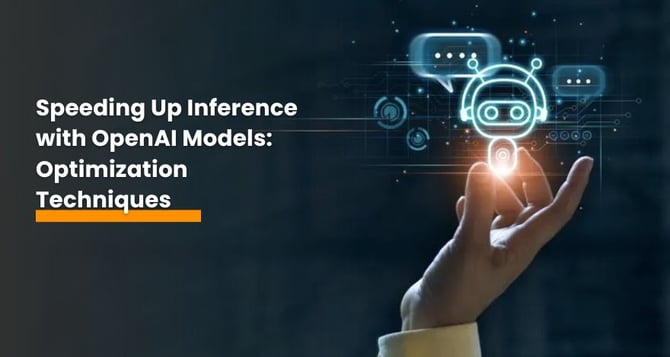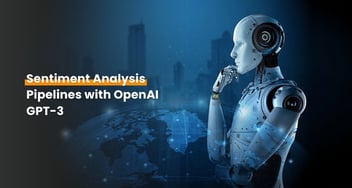Speeding Up Inference with OpenAI Models: Optimization Techniques
Learn how to optimize the inference process with OpenAI models like GPT-3 for faster performance in production environments. Explore techniques such as model pruning, quantization, distillation, and more.

OpenAI's language models, such as GPT-3, have revolutionized natural language processing tasks. However, as powerful as they are, these models can be computationally intensive, leading to slow inference times in production environments. In this article, we'll explore a range of optimization techniques to speed up the inference process when using OpenAI models significantly. Partnering with a Generative AI Development Company, you can ensure your models not only deliver exceptional results but also perform efficiently, enhancing the overall user experience.
Understanding the Inference Process
Before diving into optimization techniques, it's crucial to understand the inference process with OpenAI models.
1. Input Encoding: The input text is tokenized and encoded to be understood by the model. This encoding process introduces some overhead.
2. Model Inference: The encoded input is fed into the model for inference. This is the most resource-intensive part of the process.
3. Output Decoding: The model generates predictions, which are then decoded into human-readable text.
Optimization Techniques
1. Model Pruning
Model pruning involves removing unnecessary parts of a model to reduce its size while maintaining performance. You can remove specific neurons, layers, or sub-models that contribute less to the model's accuracy. Techniques like magnitude-based pruning and sensitivity-based pruning are effective.
2. Quantization
Quantization is the process of reducing the precision of the model's weights and activations. Floating-point numbers are converted to lower-precision data types (e.g., 16-bit or 8-bit integers), which reduces memory usage and accelerates computations. Quantized models can be efficiently deployed on hardware with limited resources.
3. Model Distillation
Model distillation is a technique where a smaller, lightweight model (the student) is trained to mimic the behavior of a larger, more complex model (the teacher). The smaller model can perform inference faster while maintaining comparable accuracy. This approach is particularly effective when deploying models on edge devices with resource constraints.
4. Batch Processing
Batch processing involves running multiple inference requests in parallel. By batching requests, you can take advantage of hardware parallelism and reduce the overall inference time. This technique is especially effective when deploying OpenAI models in web services or cloud environments.
5. GPU/TPU Acceleration
Utilizing specialized hardware like Graphics Processing Units (GPUs) or Tensor Processing Units (TPUs) can dramatically speed up inference. These accelerators are designed to handle complex mathematical computations efficiently and are widely supported by machine learning frameworks.
6. Caching
Caching involves storing the results of previous inference requests and reusing them for identical or similar inputs. This can significantly reduce the inference time for frequently occurring queries. However, it requires careful management to ensure that cached results remain up to date.
7. Concurrent Requests
Design your inference system to handle multiple requests concurrently. This can be achieved by using multi-threading or asynchronous programming. Handling requests concurrently can lead to better resource utilization and reduced latency.
8. Language Model Head
Fine-tune the language model for your specific application and task. Removing unnecessary heads or customizing the model's output can reduce inference time by minimizing the amount of post-processing needed.
Development and Implementation
To implement these optimization techniques, you can follow these steps:
1. Model Pruning and Quantization
These techniques typically require retraining the model with specific pruning or quantization algorithms. Libraries like TensorFlow and PyTorch provide tools for this purpose.
2. Model Distillation
Train a smaller model (the student) to mimic the behavior of the original model (the teacher) using knowledge distillation techniques. This involves minimizing the difference between the teacher's predictions and the student's predictions.
3. Batch Processing
When deploying your model in a web service or application, configure it to accept batched requests. Most machine learning frameworks provide support for batch inference.
4. GPU/TPU Acceleration
Utilize machine learning libraries and frameworks that support GPU and TPU acceleration. For example, TensorFlow and PyTorch provide GPU and TPU support out of the box.
5. Caching
Implement a caching mechanism in your inference pipeline. This can be achieved using in-memory databases or key-value stores like Redis. Be sure to define cache expiration and update policies.
6. Concurrent Requests
Develop your application to handle multiple requests concurrently. Use multi-threading, asynchronous programming, or frameworks like FastAPI to manage concurrent requests efficiently.
7. Language Model Head
Customize the output head of the language model to generate the specific results you need without unnecessary post-processing steps.
Considerations
Optimization is a trade-off between inference speed and model accuracy. Carefully evaluate the impact of each optimization technique on your specific use case to ensure that it meets your performance requirements without sacrificing too much accuracy.
Conclusion
Speeding up inference with OpenAI models is essential for responsive applications. At Signity Solutions, we specialize in optimizing OpenAI deployments. Our expertise ensures your applications run efficiently, combining techniques like model pruning, quantization, and hardware acceleration, delivering fast and accurate services. Trust us for seamless Generative AI solutions.
Accelerate Your OpenAI Journey!
Tired of sluggish AI? Reach out for custom solutions, expert insights, fast estimates, and guaranteed confidentiality. Let's fast-track your OpenAI models together!
These techniques empower you to deploy OpenAI use cases in real-time applications, making them more accessible and user-friendly. As AI models continue to advance, optimizing their deployment will be essential for providing fast and reliable services to users across various domains.


%201-1.webp)


.png?width=344&height=101&name=Mask%20group%20(5).png)






.jpg?width=352&name=Caching%20and%20Preprocessing%20for%20Low-Latency%20OpenAI%20Responses%20(1).jpg)









